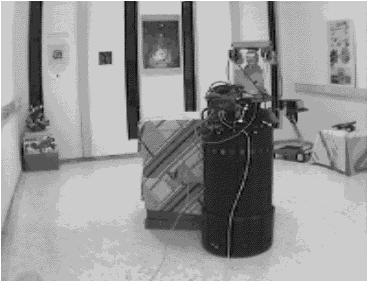
Navigation towards a user selected target with simultaneous obstacle avoidance.

by Panos Trahanias, Constantine Stephanidis and Stelios Orphanoudakis
One important application sector of Robotics is Assistive Technology. Rehabilitation robotics has advanced in recent years through the introduction of flexible manipulators (actuators), mobile platforms, fixed robotic workstations and sensor devices. Such hardware components have supplied rehabilitation robots with capabilities such as (manually-operated) manipulation, handling and low level navigation (obstacle avoidance, wall following, etc). However, more advanced navigational assistance is highly desired in order to increase the autonomy of motor impaired people and the number of tasks performed by them.
Towards this end, two research groups of ICS-FORTH, Computer Vision & Robotics and Rehabilitation Tele-informatics and Human-Computer Interaction, are joining their efforts in an attempt to study and develop navigation methods for robotic wheelchairs.
Driven by the needs of elderly and disabled people, RTD efforts that address intelligent robotic wheelchairs are underway. Such efforts are also backed by economic considerations, since the market prospects for such systems seem quite optimistic.
Most navigational approaches in current generation robotic wheelchairs are based on the measurements obtained by a ring of sonars, which can be readily interpreted for obstacle avoidance tasks. There are, however, certain limits to what can be achieved by using only local range measurements. Although they support reactivity to local environment features, they are inadequate for autonomous navigation.

Navigation towards a user selected target with simultaneous obstacle
avoidance.
To overcome the above problem, environment maps are usually employed and motion planning methods are used to yield a path from an initial configuration to a desired one. In this case, navigation is only feasible in workspaces for which a map has already been constructed. Path following is performed by some sort of odometric (dead-reckoning) technique. A non-trivial problem, however, is that path following is not error-free. Another major flaw inherent in these approaches, which also shares responsibility in the above, is the lack of any intermediate localization information.
To deal with the localization problem, radio beacons are usually introduced. Beacons, combined with planning techniques that take uncertainty into account, facilitate accurate localization and, therefore, path following. Such environment modifications are, however, very restricting since they confine robot roving in a predefined space. This is more profound in the case of robotic wheelchair platforms, where the goal is to support user mobility in various environments.
Vision can be employed to extract rich information regarding the environment from images; subsequently, it is fairly straightforward to assign semantic content to this information. On the other hand, computer vision techniques are not yet reliable enough for coping with the uncertainty and unpredictability of the real world. Thus, ongoing work at ICS-FORTH is focusing on semi-automatic navigation, relying on the user for some decisions that are hard to make automatically, and trying to combine some of the advantages of range sensing and vision by fusing information acquired by a sonar ring and a camera.
Current work focuses on navigation towards user-selected targets. Computer vision techniques are employed for target tracking; sonar-based reactivity is employed for local, fine control of motion. More specifically, the camera locks on the selected target, while at the same time the sonars are checking for obstacles that may be in the wheelchair's course. Whenever the wheelchair completes a detour for avoiding an obstacle, the camera instructs it to move in the direction of the target and approach the desired destination. The above visual capabilities facilitate an environment representation that is appropriate for the application addressed. This is the crux of this work, which integrates existing, robust methods for achieving accurate (targeted) navigation in uncontrolled environments. Special purpose hardware that is available at ICS-FORTH (mobile robotic platform equipped with vision, range sensors, on-board processing power and wireless communications) is used for experimentation and facilitates testing and demonstration purposes.
In addition to the above technologies, interfaces constitute an indispensable part of this work for allowing the user to: (a) perform target selection actions, and (b) control and direct the wheelchair operations.
Although current interface technology appears adequate for most applications, the specific requirements of a robotic wheelchair present numerous challenges. The subject of user interfaces for disabled has been systematically approached in recent years at our Institute and pioneering solutions, such as the concept and the technological platform of User Interfaces for All have been proposed. Our current efforts in the context of the Robotic Wheelchair is to develop adaptable interfaces, configurable to the individual needs of the target (wheelchair) user.
Please contact:
Panos Trahanias - ICS-FORTH
Tel: +30 81 391 715
E-mail: trahania@ics.forth.gr